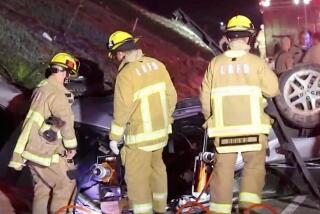When Freeways Are Clogged, Drivers Seek Exits
The guy ahead of me spotted the accident, a fender-bender just past the Santa Monica Boulevard exit on the northbound Hollywood Freeway that had tied up traffic all the way to downtown.
He slalomed across a couple of lanes to get off the freeway before traffic stopped altogether, and I decided to follow him, convinced that I could zip off the freeway and zip right back on again at the next entrance, cleverly missing the accident and speeding my way home.
There was just one catch: There is no easy place to reenter the freeway from the Santa Monica Boulevard offramp.
I don’t know what happened to the other driver, but I had to wander around quite a bit before I found another freeway entrance. I saw one at Fountain Street and Western Avenue, but I was in the right-hand lane and the entrance was on the left. I finally reentered the freeway at Hollywood Boulevard, having wasted 12 minutes going just two exits down the road.
Which raises a frequent Los Angeles driving question: When the freeways are clogged, can you get where you’re going any faster if you take surface streets?
Alex Peleshok, a retired United Parcel Service driver who became a cabdriver, said that in his experience, it’s always faster to take the freeway.
“People try to avoid the freeway on streets, and they run into red lights, ambulances, somebody’s dog, you name it,” said Peleshok, who lives in Glendale. “By the time you get there, you’ve defeated your purpose.”
Janice Austin, who commutes downtown from Sun Valley every day, uses a popular city street shortcut to get to her job as a legal secretary among the Bunker Hill high-rises.
She takes Interstate 5 south to Stadium Way, then winds through Elysian Park to Sunset Boulevard, turning east to downtown from there and avoiding congestion on the southbound 5 or the Harbor Freeway.
But Austin doesn’t actually believe the shortcut saves any time. What it does preserve, she says, is her sanity. “It’s safer, and more direct,” she said of her route.
It provides a little scenery, Austin said, and makes her think she’s going faster even when she’s not.
It’s a psychological boost that should not be underestimated.
John Fisher, assistant director of the Los Angeles Department of Transportation, said that if you know where you’re going, surface streets can provide a measure of predictability that freeways cannot.
Take, for example, the decision to use Olympic Boulevard instead of the Santa Monica Freeway as a route to the Westside from downtown.
This route is a favorite of taxi driver Adal Shoayirget, who forsakes it only for those pushy fares who insist on a freeway ride.
But is it faster? Shoayirget says it is. Then he changes his mind and says it’s not.
Following Olympic through Koreatown all the way out to Century City can actually take a little longer than the same trip would take on the freeway, Fisher said. But there’s a rhythm to it that gives drivers a sense of control.
“It may be sometimes a little bit slower, but you pretty much know how long it’s going to take to get from here to there,” he said.
The city used to track how fast it took to get from one place to another, using the information to better lay out roads and plan for traffic. But Fisher said there hasn’t been money for such frivolities in more than two decades.
There is, however, a city Web site, trafficinfo.lacity.org, that shows the average speed on streets within Los Angeles. It has a link to the traffic Web site www.sigalert.com, which shows freeway speeds.
Commuters who have access to the Internet at work and don’t mind spending part of their precious driving time (or some of the boss’ time) flipping back and forth between the two sites can get some idea of the conditions before they head out.
“I used to think it was faster to get off the freeway but now I don’t ... because enough people get off the freeway to make both routes equally slow,” said Jon Berke, co-founder of Sigalert.com.
His business, which was started in part to answer the question of whether city streets move faster than a clogged freeway, provides traffic reports to The Times and can be reached from a number of Web sites.
Getting off the freeway only helps, Berke said, if a commuter knows before anybody else where an accident has taken place, in order to get off before everybody else clogs up the side streets. A driver also would have to know exactly where to get back on.
Which is not to say that Berke is recommending that we all drive only on the freeway.
“Your car is moving, and there’s more stuff to look at,” said Berke, a San Diego resident for whom jumping off the freeway generally means a trip down the coast road. “Even if traffic is stop-and-go on the coast, it’s better than being stop-and-go in the middle of the concrete jungle.”
Plus, he said, there’s always that chance that you’ll save a little time. It’s a bet that even the most traffic-savvy drivers can’t seem to resist.
“Last week, I made the wrong decision,” said Fisher of the L.A. Transportation Department. “As soon as I exited the freeway, I could see that the tie-up was right ahead of me.”
*
If you have a question, gripe or story idea about driving in Southern California write to Behind the Wheel c/o Los Angeles Times, 202 W. 1st St., Los Angeles, CA 90012, or send an e-mail to behindthewheel@latimes.com.
More to Read
Sign up for Essential California
The most important California stories and recommendations in your inbox every morning.
You may occasionally receive promotional content from the Los Angeles Times.









